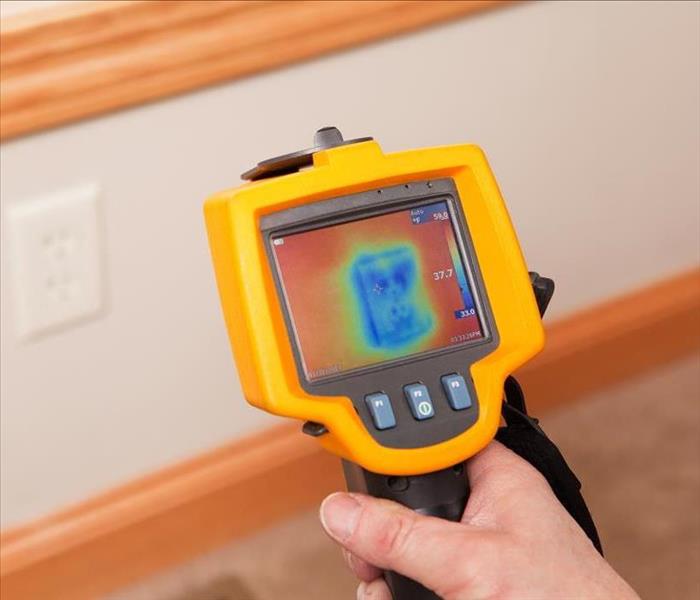Are Wet Properties Expensive to Repair in Exeter?
12/9/2021 (Permalink)
 SERVPRO's advanced inspection and mitigation equipment prevents secondary water damage to Exeter homes
SERVPRO's advanced inspection and mitigation equipment prevents secondary water damage to Exeter homes
Residents of Exeter Can See Expenses Spiral when Water Damage Strikes.
SERVPRO is a qualified restoration service that can mitigate costs and repair your home.
Why do wet properties deteriorate?
Water problems can degrade over time, causing extensive harm to your Exeter home. When dry materials are exposed to moisture, it can affect their structural integrity and promote harmful microbial activity. The combination of water exposure and microbial growth can lead to long-term problems affecting building materials, drywall, and fabrics in the home. If you discover water intrusion, it is vital that you contact your insurer right away. The first three days of a water emergency are central to the overall cost of restoration. SERVPRO technicians can enter the property, assess potential damages, mitigate damages, and begin repairing your water-damaged Exeter home. A standard water restoration from start to finish typically takes between two and five days to recover with professional help.
Is rising humidity harmful to a property?
One of the causes of water damage in your Exeter home may be rising humidity levels. When large bodies of water enter an enclosed environment, it begins to evaporate. Evaporation leads to higher levels of humidity within an indoor environment. When this humid air comes into contact with cold, dry surfaces, it condensates. This condensation effect can quickly lead to the ceiling, wall cavity, or upper floor damage. The more moisture in the air- relative humidity- can slow down the evaporation process overall, leading to more water exposure and a more extended restoration project. SERVPRO technicians typically bring in humidity controls at the first opportunity to mitigate further damages in a wet property.
What effect does condensation have on the property?
- Damp spots can quickly become hotbeds for microbial activity, including fungi, viruses, or bacteria
- Inner wall cavity damage can stagnate, causing unpleasant odors and cracking paintwork
- Damage to drywall, insulation, or paintwork is often discernible through discoloration
How does water restoration begin?
The first question that a professional water restoration technician asks is what is wet. We usually start at the source of water intrusion, which is generally identifiable as a slow leak, faulty appliance, or cracks leading to rainwater intrusion. From here, our technicians can work outwards to understand the extent of water migration. Sometimes it is necessary to use advanced measuring equipment to understand the scope of water migration truly. These may include the use of thermal imaging cameras or boroscopes. If a technician suspects that migration has reached wall cavities, we may need to perform a demolition to expose the hole and assess its insulation. Wet materials like insulation or drywall are typically inexpensive to replace and can be reinstalled by a qualified SERVPRO technician.
What equipment can be used to fix water migration issues?
- Structural cavity drying equipment like Injectidry systems can help to dry a property without requiring demolition
- Drying mats cover a large surface area and are useful for drying floors made from vinyl, laminate, or masonry
- Adaptations to dehumidification or air-moving equipment to allow hot, dry air to circulate into the home's hidden recesses
How do technicians know when a property is dry?
The drying of a property is an exact science. SERVPRO technicians use thermal hygrometers to measure the humidity of the affected area. We can then compare that to unaffected rooms as well as outdoor air. The readings taken from an unchanged room become the dry goal. SERVPRO can then use air-movers and other drying equipment to match an unaffected area's dryness with the affected area. It is equally essential for technicians to monitor the effectiveness of a drying system. Different properties have different shapes and architectures, which can all affect drying. By returning daily to monitor drying outcomes, crew chiefs can adapt the drying setup in your home for maximum efficiency. Tailoring our approach this way helps to ensure that Exeter residents suffer minimum inconvenience following water restoration.
When is a water restoration project finished?
- When the dry goal of the affected area is met
- Once a SERVPRO technician conducts a walkthrough with you to explain outcomes and services
- After equipment is removed and any damaged materials are either cleaned, restored, or replaced
Can restoration services help with insurance?
Generally, a restoration crew chief works closely with an insurance adjuster. SERVPRO is a transparent, professional company that records any work carried out in a digital inventory. These works ensure that there is access to accounts in real-time. At the end of a service, our technicians can pass the details of restoration onto your insurance provider to complete a 'stress-free claim.
A wet home can continue to sustain damages after the source of moisture is contained. Contact SERVPRO of The Seacoast, SERVPRO of Dover-Rochester, and SERVPRO of Durham at (603) 433-4300 now.






 24/7 Emergency Service
24/7 Emergency Service